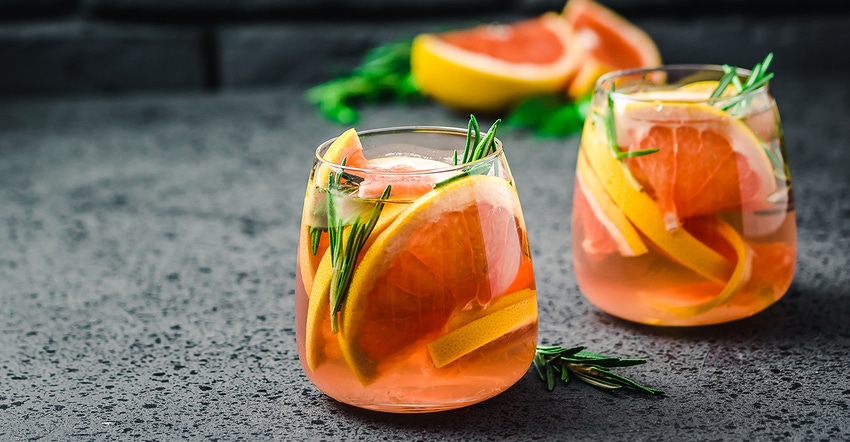Consumers still want the taste of cocktails, but with less alcohol, and they want all their drinks to benefit their health and the environment.

Control over one’s health is the underlying focus for all generations, but brand trust is a concern. InMoment reported that 67% of consumers said brands lose their trust by failing to keep promises using misleading advertising and providing poor products and services. This exposes an opportunity to partner with trusted sources as a way to gain consumer trust.
According to the Hartman Group's Modern Beverage Culture 2018 report, 65% of consumers said that the meaning of health and wellness is "feeling good about myself." And 44% of consumers said that it is important "that my beverages do something for me," like provide energy, nutrients or other benefits. Wakefield Research reported “natural” is most likely to motivate 53% of Americans to purchase a product this year, and 51% were influenced by “no preservatives”. Kerry reported consumers ranked weight (51%), stress (51%), energy (39%) and sleep (38%) as the top four personal health priorities.
The amount of sugar in foods is now the top concern of consumers, replacing price, according to the Food Standards Agency (FSA), a governmental agency responsible for protecting public health in relation to food in England, Wales and Northern Ireland. In the FSA’s biannual report, 55% of respondents said they were concerned about the amount of sugar in food. According to Pew Research, 44% of U.S. adults said they would restrict or limit consumption of artificial sweeteners, and 38% reported limiting sugar. Nielsen reported the sugar and sweetener category has declined year on year in dollar (-2.1%) and unit (-3%) sales in the 52 weeks ending July 28, 2018. Fermented beverages and ingredients are growing as well with Upserve reporting that consumption of fermented foods and drinks increased 149% during 2018. University of Eastern Finland reported that fermented dairy products are associated with lower heart disease risk.
2019 brought consumer tastes back to classic, pure and simple options for their beverages. Consumers aren’t looking for experimentation with their beverages, and instead are looking to drinks and habits of yesteryear.
Session cocktails and mocktails remain in spotlight
Low and no-alcohol beverages take the spotlight, with the rise led by Millennials, though other generations are following suit. “Session” is a term used for low-alcohol drinks and mocktails aimed at a more moderate adult demographic. These drinks are the perfect hybrid as they maintain their adult status and appeal while not betraying overlapping health trends. They are easy to replicate at home and can make appearances in retail, as seen with some of the new sparkling spiked water launches. Their greatest strength lies in the fact that they are a near-perfect Pandora’s Box—an unstoppable trend with no adversaries or competitors. The players getting the most press include switchels, drinking vinegars, kefir, hard sodas, spiked waters, hard ciders and any classic cocktails that are complex enough to endure when alcohol is removed, such as the Tiki crowd.
The International Wines and Spirits Record (IWSR) predicted low- and no-alcohol products in the U.S. will grow 32.1% between 2018 and 2022, as U.S. alcohol volumes dropped 0.8% in 2018, and 52% of adults who drink alcohol are either trying now or have tried before to reduce their alcohol intake.
Coffee, tea play on both sides of the fence
Tea and coffee are both darlings of the non-alcohol scene. They act as chameleons moving between food and beverage categories, and both have the backing of clinical health research to strengthen their position.
The National Coffee Association reported that Americans drinking coffee daily increased to 64%, up from 62% in 2017 and 57% in 2016. Non-espresso-based beverages, including cold brew, were consumed by 11% of consumers the previous day; 13% drank frozen blended coffee drinks the previous day, and 4% drank nitrogen-infused beverages.
The Tea Association confirmed that tea can be found in almost 80% of all U.S. households.
Both tea and coffee ricochet between alcohol and non-alcohol beverages and show up in hot and cold formats. This ability lengthens their time in the spotlight, since they can behave as the leading lady or the best friend. Tea can fall under tea latte, kombucha, nitro-infused, mushroom, cascara, butterfly pea flower, green, cheese or spiced iced. Coffee can be classified as nitro-infused, house-roasted, cold brew, mushroom or functional.
Plant waters & milks play across beverage categories
Plant waters and milks are the other two darlings of the non-alcohol scene, but now are crossing into the cocktail scene. However, they do not have the strong clinical health backing that tea and coffee enjoy. Where plant water and milk excel is in their wide-ranging voice. Like tea, plant waters and milks come from a wide variety of sources including pea, hemp, barley, flax, oat, quinoa, maple, cactus and coconut. These ingredients lead different lives, have different voices and different best friends, so they can play across categories. They can act as the leading lady or the best friend equally well.
Preps, mixers, & add-ins act as the party dress
Add-ins and preps are the experimental frontier for beverages. They act as the party dress for the beverage and allow consumers to experiment while still experiencing something familiar and approachable. This is a territory in which it would be easy to make a mistake right now; brands should keep the base drink familiar and approachable and use the add-in or prep as the party dress. Consumers are not in a risk-taking mood. Brands can create hybrids by combining a familiar, retro or historical base with trend-forward add-ins, mixers or preps. Preps may include barrel aging, unfiltered, nitro, fermented or Instagram-worthy. Mixers and add-ins showcase items such as botanicals, pickled items, cannabis, grains, aquafaba, natural sugars, infused ice or florals.
The International Food Information Council (IFIC) reported that taste was rated the No. 1 factor, with 81% of consumers stating taste impacts their decisions. Similarly, Mintel and Synergy reported 75% of consumers are influenced by flavor choice when purchasing a sports nutrition product. The global floral flavor market is predicted to grow at a CAGR of almost 10% from 2018 to 2022, according to Technavio.
Sustainability
Sustainability is a Pandora’s Box; it’s a virtually unstoppable trend having no adversaries and little or no competition. The only way to fail at this trend is to not engage. Nielsen reported U.S. organic sales surpassed $21 billion in the 52 weeks ending Nov. 24, 2018, up nearly 9% from the previous 52 weeks. Earthbound Farm found 40% of shoppers expected to increase the amount of organic products they buy in 2019. Nielsen reported that 48% of U.S. consumers say they would change their consumption habits to reduce their impact on the environment. Meanwhile, Cargill Inc. reported that more than 50% of Gen Y participants changed their eating habits for sustainability reasons in the past year versus 19% of older U.S. respondents. It is best for brands to place wide nets and engage several sustainability trends within a product. Brands should market how a sustainability feature benefits the consumer, not their company.
A suggested beverage formula for success will:
Keep the base or backbone of the beverage approachable, and tied to history or regional specialty;
Use add-ins, preparation or presentation to add intrigue and prevent it from being 100% comfort food;
Empower consumers have control over improving their environment and health by using the products.
Suzy Badaracco is the president of Culinary Tides Inc. and holds a bachelor’s degree in criminalistics, associate degree in culinary arts, and master’s degree in human nutrition. Badaracco has been trained in military intelligence, chaos theory and predictive analysis techniques, and has been practicing trends intelligence and predictive forecasting for more than 15 years.
About the Author(s)
You May Also Like






